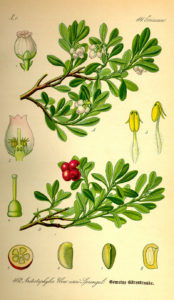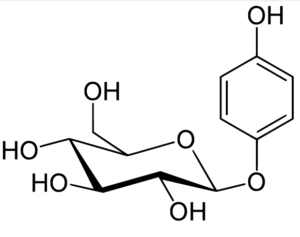Plants and the chemicals they make. Is alpha arbutin extracted from bearberry?
Let’s start at the begiining.
What is bearberry? A plant.
What is arbutin? A chemical.
Now that we sorted that out, let’s look at the details.

Figure. Thomé Flora von Deutschland, Österreich und der Schweiz 1885.
This is a plant that has been used in folk medicine to alleviate an assortment of ailments. It contains many phytochemicals, some of them good for you, others not so much. Among those chemicals is arbutin.
Arbutin is a derivative of hydroquine present in many plants. Other names are arbutoside and hydroquinone β-D-glucopyranoside. This means that there is a glucose attached to the hydroquinone part of the molecule in a “beta” link. The glucose molecule has a particular structure that allows it to attach to other molecules in a couple of different ways that differ in the way they are arranged in space.

Figure. Arbutin as it is made by bearberry and other plants, with the glucose moiety bound in a beta linkage.
Why does this matter? An enzyme that can break an alpha linkage in unlikely to be able to break a beta linkage. This means that the alpha and beta forms of arbutin behave in a different way in a human body.
It is also true that the natural form, beta arbutin, has been used for centuries, so we have information about what it does to the body (and the skin).
Conversely, the arbutin with the glucose linked in alpha has been created recently in a laboratory.
Does it matter, natural or synthetic? No, what matters is that they will behave differently and that Skin Actives does not use the alpha form because we do not have enough information.
Why use alpha arbutin, the “novelty” form? No good reason. It is supposed to inhibit melanin synthesis in a similar way, but there are too many unknowns. In other words, I would be happy to use arbutin, the beta glucoside, obtained from plants or from a laboratory. The body could not distinguish whether it was made by a plant or a person. But the body can tell whether it is alpha or beta glucoside.
Somebody should tell the skin care industry about the Precautionary Principle. Here it is, in Wikipedia. In the industry, novelty is seen as a virtue when, in reality, it is a anything but. Older ingredients have accumulated more information about possible side effects.
